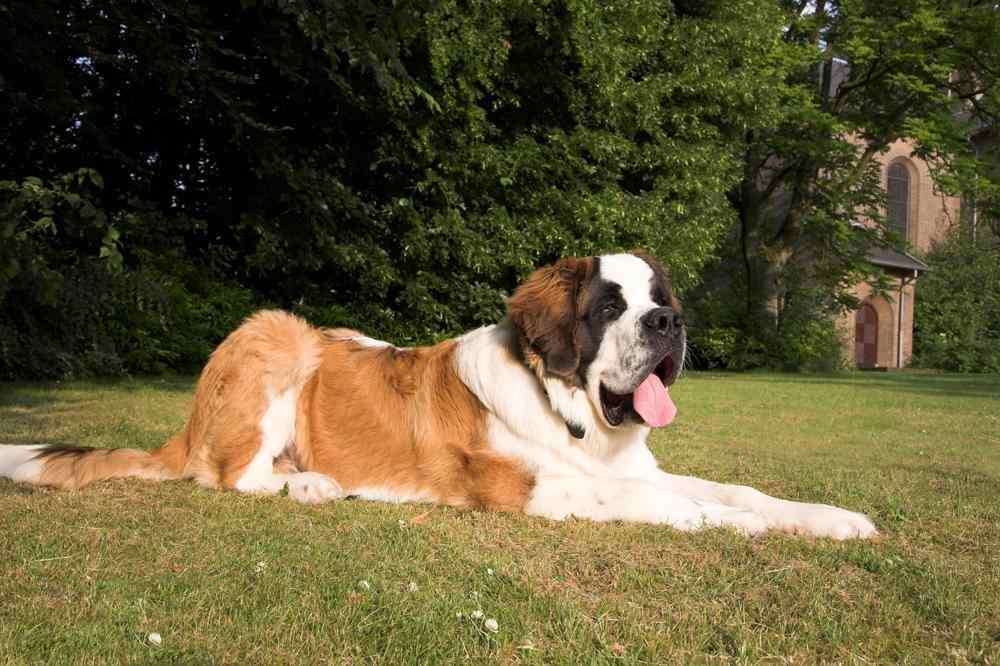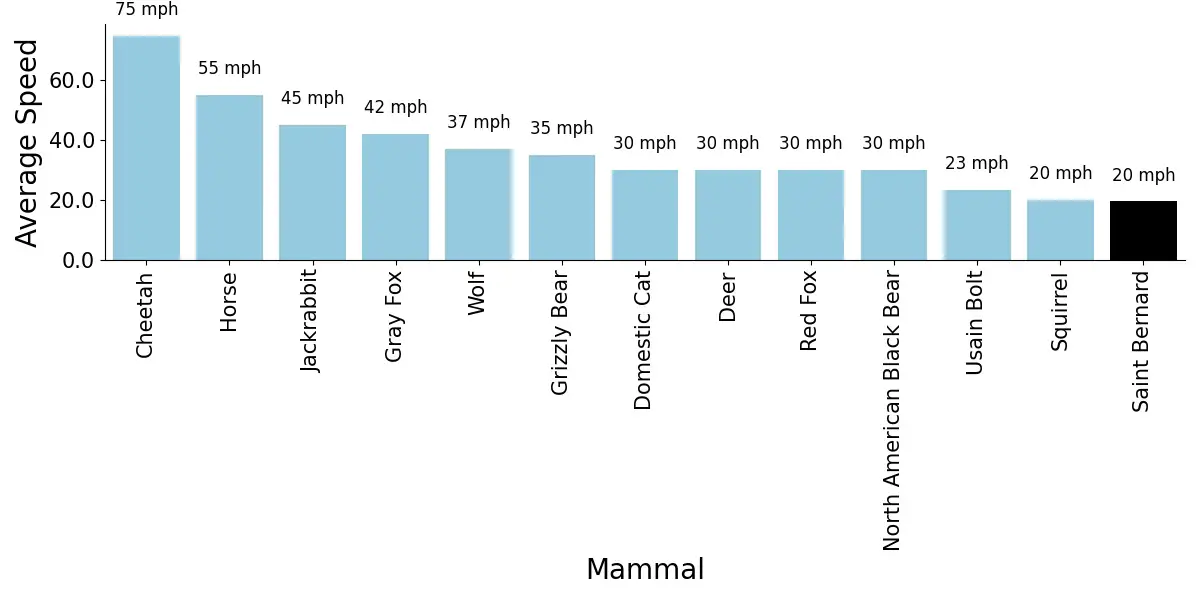Quick Links: Table of Contents
- Saint Bernard Breed Overview
- History of the Saint Bernard Breed. Where Saint Bernards came from
- What the Saint Bernard Looks Like
- How Much is the Saint Bernard Puppy?
- Best Saint Bernard Breeders
- Saint Bernard Growth
- The Temperament of the Saint Bernard
- How Long Saint Bernards Live
- Saint Bernard Litter Size
- How Fast Saint Bernards Can Run
- Good Names for Saint Bernards
- How Intelligent are Saint Bernards?
- How Popular are Saint Bernards with New Dog Owners?
- Health Problems in Saint Bernards and How to Prevent Them
- How to Take Care of Saint Bernard
- Dog Breeds That Are Similar to Saint Bernards
- Other Things to Know About Saint Bernards
Saint Bernard Breed Overview
The Saint Bernard is a giant-sized dog.
The adult Saint Bernard stands 2 feet, 2 inches to 2 feet, 6 inches tall at the s.
The Saint Bernard belongs to the Working Dogs group.
Dogs in the Working Dogs group, like the Saint Bernard, were developed to assist humans in some capacity – including pulling sleds and carts, guarding flocks, guarding homes, and protecting their families.
Breeds in the Working Group are known for their imposing stature, strength, intelligence, and fearless.
Because of their size and strength, working dogs require a structured home life and firm, fair, consistent training by someone who can provide leadership without resorting to anger or physical force.
The fact that the Saint Bernard belongs to the Working Dogs group is one of the reasons why Saint Bernards have the personality and temperament that they have.
The temperament of the Saint Bernard is generally described as:
- Calm
- Friendly
- Gentle
- Lively
- Watchful
History of the Saint Bernard Breed. Where Saint Bernards came from
Saint Bernards are one of the most iconic breeds of dogs, known for their large size and friendly demeanor.
But where did these gentle giants come from? The Saint Bernard is believed to have originated in the Swiss Alps, where they were used as working dogs by monks.
Saint Bernards were originally bred for their strength and ability to navigate through snow, and they soon became invaluable members of the monks` mountain rescue teams.
In 1820, a Saint Bernard named Barry became famous for rescuing more than 40 people from avalanches.
Today, Saint Bernards are still prized for their loyalty and affection, and they make wonderful companions for families all over the world.
.
What the Saint Bernard Looks Like
Saint Bernards are loyal, patient, and loving dogs that make great companions.
Saint Bernards have a thick, dense coat that is usually red or brown with white markings.
Their coat helps to protect them from cold weather, and they have been known to withstand temperatures as low as negative 40 degrees Fahrenheit.
Saint Bernards also have a long tail that is often used as a natural blanket to keep their body warm.
Overall, Saint Bernards are impressive dogs that are well-suited for cold climates.
.
How Much is the Saint Bernard Puppy?

The average price of a Saint Bernard puppy is $1320. The price of a Saint Bernard puppy ranges from $875 to $1525.
A lot of factors determine the price of the Saint Bernard. These factors include what health records the Saint Bernard puppy has, the lineage of the Saint Bernard puppy, the US state the breeder is located in, etc.
To estimate how much you can expect to pay for a puppy Saint Bernard based on the many factors that determine the price of the Saint Bernard puppy, check out our calculator that lets you estimate how much you should expect to pay for the Saint Bernard puppy based on what you want in the puppy.
When looking to buy a puppy, look at buying a puppy only from well-established breeders that breed puppies primarily for the love of the Saint Bernard breed, and secondarily for profit. Do not buy a puppy from a puppy mill. Puppy mills mass-produce puppies in bad living conditions for maximum profit.
You may also consider adopting instead of buying a puppy. Adoption costs are very low compared to the price of a puppy.
Best Saint Bernard Breeders

We have researched reputable Saint Bernard breeders that you can buy a puppy.
Go to this page for our complete list of reputable Saint Bernard breeders in various states in the United States.
On this page, you will see how much these breeders sell their puppies for, and how many puppies they have available.
A few of these breeders are listed below.
R & D Farms
Puppy Price: Check with breeder
Kerrie Ike
Puppy Price: Check with breeder
Missouri Murphy Saints
Puppy Price: $1400
Spring Mountain
Puppy Price: Check with breeder
Mountain Woods Saint Bernards Galaxy pugs
Puppy Price: Check with breeder
Saint Bernard Growth

New Saint Bernard owners need to know about the growth of their Saint Bernards. This will help them plan their living spaces accordingly.
Also, knowing the typical growth pattern of the Saint Bernard will help new owners catch the abnormal growth of their Saint Bernard early.
See our calculator for predicting how big your Saint Bernard puppy will get. You will also learn about the typical weight of the Saint Bernard at different ages and how to catch abnormal growth in your Saint Bernard


The Temperament of the Saint Bernard
The temperament of the Saint Bernard based can be summarized as in the table below.
The table shows the scores of the Saint Bernard for 13 important dog behavioral factors.
We obtained these scores by analyzing raw data from the C-BARQ dog personality survey tool. The higher the score of a dog for a factor, the worse the temperament of the dog regarding that factor.
The C-BARQ tool was developed by researchers from the University of Pennsylvania, and it is a scientific tool that is used worldwide for reliably measuring the temperament of dog breeds.
See our complete analysis of the temperament of the Saint Bernard here.
| Factor | Score |
|---|---|
| Dog Directed Aggression | 63.0 percent |
| Dog Directed Fear | 56.8 percent |
| Nonsocial Fear | 54.0 percent |
| Stubbornness | 53.5 percent |
| Dog Rivalry | 5.9 percent |
| Attachment Attention Seeking | 49.6 percent |
| Excitability | 47.3 percent |
| Energy Level | 46.7 percent |
| Stranger Directed Fear | 44.7 percent |
| Stranger Directed Aggression | 39.9 percent |
| Prey Drive | 27.0 percent |
| Separation Related Behavior | 26.1 percent |
| Owner Directed Aggression | 22.6 percent |
| Touch Sensitivity | 12.8 percent |

How Long Saint Bernards Live
The lifespan of the Saint Bernard is typically from 8 to 10 years.
Moreover, a few years back, veterinarian researchers performed a scientific study to determine the lifespan of the Saint Bernard. In this study, the scientists collected data on how long 53 pet Saint Bernards lived.
From the study, it was found that Saint Bernards have an average lifespan of 7 years. Furthermore, the study found that it is not uncommon for Saint Bernards to live as long as 12.7 years.
Note that you need to put in some effort if you want your Saint Bernard to live long.
Saint Bernards live long if they eat well, drink well, exercise well, and visit the veterinarian regularly.
There are also dog supplements that you can give your Saint Bernard to improve your Saint Bernard`s quality of their life.
Click here to learn more about how to make your Saint Bernard live long.

Saint Bernard Litter Size
Researchers from the Norwegian School of Veterinary Science did a study where they counted the numbers of puppies in 45 different Saint Bernard birth litters.
From this study, the researchers found that the average number of puppies that Saint Bernards can have is 6 puppies. Also, the Saint Bernard can have as few as 1 puppies per litter and as many as 18 puppies per litter.
The number of puppies that the Saint Bernard will have depends on factors such as the age of the Saint Bernard, the method of pregnancy, etc.
Click here to see our calculator for predicting how many puppies your Saint Bernard will have and how the litter size of the Saint Bernard compares to the litter size of other dog breeds.
How Fast Saint Bernards Can Run

How fast a dog breed can run is a good measure of how athletic the dog breed is.
The American Kennel Club (AKC) regularly conducts dog running competitions. The AKC records the running speed of competing dogs in these competitions. These competitions are open to all dog breeds.
Based on our analysis of the speeds of 18 different Saint Bernards, the average speed of the Saint Bernard is 19.5 mph (31.3 kmph).
The fastest speed on AKC record that the Saint Bernard ran in a race is 23.84 mph (38.4 kmph) and the minimum speed on record in a race for a Saint Bernard is 11.63 mph (18.7 kmph).
Click here to see how the speed of the Saint Bernard compares to the speed of other dogs and other mammals such as cats, horses, humans, etc.

Good Names for Saint Bernards
Here are some really good names that are typical for the Saint Bernard ranked by popularity:
- Beethoven
- Bernie
- Moose
- Max
- Duke
- Coonfoster
- Chief
- Biggie
- Ranger
- Fergus

How Intelligent are Saint Bernards?
| Saint Bernard | |
|---|---|
| Intelligence Rank | 65 out of 130 dog breeds |
| Trainability | Tend To Learn New Commands After 40 To 80 Repetitions! |
According to Prof. Stanley Coren, a Canadian psychology professor/dog trainer, the total intelligence that a dog demonstrates is the addition of three types of intelligence. These intelligence types are:
- Instinctive Intelligence: This is the natural intelligence that comes from instinct. For example, dog breeds that have been historically bred to be guard dogs will have a high `guarding` intelligence compared to dogs that were not bred for guarding.
- Adaptive Intelligence (learning and problem-solving ability): This indicates what a dog can learn to do for himself or herself. Adaptive intelligence is specific to each dog, and not breed specific. You can improve your dog`s adaptive intelligence by investing time to train your dog.
- Working/Obedience Intelligence: This type of intelligence is breed-specific. Certain dog breeds tend to have higher working/obedience intelligence than some other breeds. This intelligence is the closest to what we might call school-learning ability and it is based upon what the dog can learn to do when instructed by humans. This type of intelligence can be measured for each dog breed and compared to that of other dog breeds.
Professor Stanley Coren measured and ranked the working intelligence of about 130 different dog breeds.
Prof. Coren found that the Saint Bernard has an obedience intelligence rank of 65 out of 130 dog breeds. Thus, Prof. Coren put Saint Bernards in the `Fair Working/Obedience Intelligence Dogs` category.
This means that Saint Bernards tend to learn new commands after 40 to 80 repetitions!.
However, we should mention that a dog should not be judged based on its intelligence alone. There are other important factors you need to consider when deciding on which dog breed to get. These other factors include sociability, adorability, and compatibility of the dog breed with your lifestyle.
See the intelligence ranking of some other dog breeds below:
| Breed | Intelligence Rank |
|---|---|
| Border Collie | 1 |
| Shetland Sheepdog | 6 |
| Papillon | 8 |
| Rottweiler | 9 |
| Miniature Schnauzer | 12 |
| English Springer Spaniel | 13 |
| English Cocker Spaniel | 18 |
| Belgian Malinois | 22 |
| Chesapeake Bay Retriever | 27 |
| Welsh Springer Spaniel | 31 |
| Affenpinscher | 37 |
| Bedlington Terrier | 40 |
| Ibizan Hound | 53 |
| Akita | 54 |
| Skye Terrier | 55 |
| Old English Sheepdog | 63 |
| Bull Terrier | 66 |
| Pekingese | 73 |
| Chow Chow | 76 |
| Afghan Hound | 79 |

How Popular are Saint Bernards with New Dog Owners?
Every year, the American Kennel Club (AKC) publishes information on how popular a dog breed is in that particular year. The AKC gets the popularity information of a breed from how many dogs of that breed the owners register with the AKC every year. The AKC collects this data for about 200 dog breeds.
The graph below shows the popularity trend of the Saint Bernard.
The popularity of the Saint Bernard averaged over the years is Number 49 out of about 200 dog breeds.

Do not get a dog breed just because it is a popular dog breed. And do not reject a dog breed just because it is an unpopular breed.

Health Problems in Saint Bernards and How to Prevent Them
Every dog breed has its own set of health problems that it tends to develop. There is nothing like a perfect dog breed.
The Saint Bernard is prone to certain genetic health conditions. The Orthopedic Foundation for Animals (OFA) is an organization that keeps track of genetic health problems in dog breeds.
From the extensive records that the OFA keeps, the OFA knows what health problems each dog breed is naturally prone to develop.
Hence, the OFA recommends which health screening breeders should perform on a dog breed to make sure that the breeders won`t breed `defective` dog parents that can pass down defective genes to their puppy offspring.
If you want a Saint Bernard puppy that will grow up to be healthy, make sure that your Saint Bernard breeder screens your puppy or your puppy`s parents for the health problems that the OFA recommends for your puppy`s breed. This will increase the chances that your puppy is free from genetic defects.
The following are the health tests that Orthopedic Foundation for Animals (OFA) recommends that breeders should screen Saint Bernards for:
- Autoimmune thyroiditis
- Cardiac Evaluation – Min Age 24 Months
- Degenerative Myelopathy
- Elbow Dysplasia – Min Age 24 Months
- Eye Examination – Min Age 22 Months
- Hip Dysplasia – Min Age 24 Months
You can find out more about OFA`s recommended tests for Saint Bernards here.

How to Take Care of Saint Bernard
To take good care of your Saint Bernard, you need to make sure that you groom your Saint Bernard regularly.
Secondly, you need to find a veterinarian in your area that will routinely check the health status of your Saint Bernard regularly, and give you appropriate recommendations on your Saint Bernard`s preventative care.
Thirdly, you need to commit some time to exercise your Saint Bernard daily. Regular exercise helps improve the health and quality of life of your Saint Bernard.
Also, you need to feed your Saint Bernard high-quality dog food, and the food should be of the right amount to prevent your Saint Bernard from getting overweight or underweight.
See our recommendations on what to feed the Saint Bernard and how much food to feed the Saint Bernard at different life stages.
Finally, you need to make sure that your Saint Bernard has access to clean water all the time. See our recommendations on how much water your Saint Bernard needs to drink at different ages.
Dog Breeds That Are Similar to Saint Bernards
If you have not made up your mind on which dog breed to get, you may also want to consider some other dogs similar to the Saint Bernard.
We crunched the numbers and found that the following dog breeds that have similar behavior and temperament as the Saint Bernard:
- Newfoundland (68 percent match with Saint Bernard). Learn more about the Newfoundland here.
- King Shepherd (71 percent match with Saint Bernard). Learn more about the King Shepherd here.
- Spinone Italiano (68 percent match with Saint Bernard). Learn more about the Spinone Italiano here.

Other Things to Know About Saint Bernards
Here are some of the very important characteristics of the Saint Bernard that you need to know about the Saint Bernard breed:



